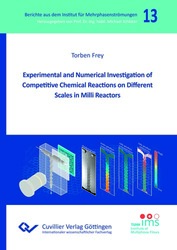| Departments | |
|---|---|
| Book Series (96) |
1378
|
| Nachhaltigkeit |
3
|
| Gesundheitswesen |
1
|
| Humanities |
2365
|
| Natural Sciences |
5406
|
| Engineering |
1793
|
| Engineering | 292 |
| Mechanical and process engineering | 862 |
| Electrical engineering | 686 |
| Mining and metallurgy | 30 |
| Architecture and civil engineering | 75 |
| Common |
98
|
|
Leitlinien Unfallchirurgie
5. Auflage bestellen |
|
Advanced Search
Experimental and Numerical lnvestigation of Competitive Chemical Reactions on Different Scales in Milli Reactors (Volume 13) (English shop)
Torben Frey (Author)Preview
Extract, PDF (10 MB)
Table of Contents, PDF (130 KB)
The application of modular continuous-flow equipment enables more efficient and greener chemical processes through precisely defined process windows and new synthesis pathways. Despite the advantages, continuous-flow processes are sparsely favored over large-scale batch processes in the chemical industry due to today’s lack of detailed understanding of micro mixing performance and selectivity of chemical reactions in laminar flow regimes. This thesis reviews and proposes numerical and experimental methods for quantifying micro mixing and its influence on selectivity in competitive chemical reactions.
The transport properties of a laminar-flow liquid-liquid mixing problem with chemical reactions is investigated by experimental and numerical methods. A modular split-and-recombine (SAR) mixing unit is used as a benchmark geometry. First, direct numerical simulations (DNS) are performed for a range of Reynolds and Schmidt numbers (1≤Re≤400, 1≤Sc≤3600) to determine micro mixing length scales required for full problem resolution. For validation, two different experimental setups are introduced. Confocal laser-scanning microscopy (CLSM) reveals three-dimensional concentration distributions and pH distributions of an acid-base reaction, confirming the simulation results and coinciding with the data from the literature. Furthermore, the two-dimensional concentration distributions of reagents and products of the said reaction are recorded simultaneously with imaging UV-Vis spectroscopy. Second, the Villermaux-Dushman protocol (VD protocol) is investigated in detail with CFD simulations, experimental methods, and micro mixing models to determine micro mixing time scales and reaction selectivity. The VD protocol is a well-established method for quantifying micro mixing performance in aqueous solution inprocess equipment. The one-dimensional micro mixing model (incorporation model) is used to link the global selectivity to the micro mixing time of the mixing unit. The local concentration distributions obtained from the imaging UV-Vis spectroscopy highlight the importance of local flow phenomena in the overall mixing process, which cannot be captured by the one-dimensional micro mixing model. Finally, the developed methods are transferred to a reaction system of the nitrosyl iron complex (NIC) in organic solution, which enables the direct measurement of local selectivity distributions by imaging UV-Vis spectroscopy. The incorporation model of the new reaction system is validated by the micro mixing times determined with the Villermaux-Dushman protocol. The investigated SAR mixing unit shows a wide range of local selectivity and micro mixing time distribution, and the unfavored product is formed almost exclusively in areas above the global mean mixing time.
The approaches applied in this thesis paint a detailed picture of the micro mixing processes in the modular mixing unit. The locally resolved selectivity and micro mixing time distributions yield multiple anchor points in equipment optimization. Detailed knowledge of the local mixing phenomena is essential to predict selectivities and consequently accurately designing efficient continuous processes that are capable of outperforming existing batch processes.
Kontinuierlich betriebene modulare Anlagen ermöglichen effizientere und umweltfreundlichere chemische Prozesse, da sie in genau definierbaren Prozessfenstern betrieben werden können und neue Syntheserouten ermöglichen. In der chemischen Industrie werden kontinuierlich betriebene Prozesse trotz der Vorteile nur selten großtechnischen Batch-Prozessen vorgezogen, da das detaillierte Verständnis der Mikrovermischgung und der Selektivität chemischer Reaktionen in laminaren Strömungsregimen bisher fehlt. In dieser Arbeit werden numerische und experimentelle Methoden zur Quantifizierung der Mikrovermischung und ihres Einflusses auf die Selektivität von kompetitiven chemischen Reaktionen untersucht und präsentiert.
Die Transporteigenschaften eines flüssig-flüssig-Mischproblems mit chemischen Reaktionsnetzwerken in laminarer Strömung werden durch experimentelle und numerische Methoden untersucht. Ein modularer Split-and-Recombine (SAR) Mischer wird als Referenzgeometrie verwendet. Zunächst werden direkte numerische Simulationen (DNS) für eine Reihe von Reynolds- und Schmidtzahlen (1≤Re≤400, 1≤Sc≤3600) durchgeführt, um die Auflösung der Längenskalen der Mikrovermischung zu bestimmen. Die Validierung wird anhand zweier experimenteller Ansätze erreicht. Konfokale Laserscanning-Mikroskopie (CLSM) löst dreidimensionale Konzentrations- und pH-Verteilungen einer Säure-Base-Reaktion auf. Des Weiteren werden zweidimensionale Edukt- und Produktkonzentrationsfelder simultan mithilfe der bildgebenden UV-Vis-Spektroskopie aufgenommen. Als nächstes wird das Villermaux-Dushman-Protokoll (VD-Protokoll) mittels CFD-Simulationen, experimentellen Methoden und Mikromischmodellen detailliert untersucht. Das VD-Protokoll ist eine weit verbreitete Methode, um Mikrovermischung in Mischprozessen in wässriger Lösung zu quantifizieren. Das Mikromischmodell (Inkorporationsmodell) wird genutzt, um die global gemessene Selektivität einer Mikromischzeit des Mischers zuzuordnen. Die lokalen Konzentrationsfelder aus der bildgebenden UV-Vis-Spektroskopie heben die Bedeutung lokaler Strömungsphänomene im Mischprozess hervor, welche nicht durch das eindimensionale Mikromischmodell dargestellt werden können. Abschließend werden die entwickelten Methoden auf ein Nitrosyl Eisenkomplex-Reaktionssystem (NIC) in organischer Lösung übertragen, welches die direkte Messung lokaler Selektivitätsverteilungen durch die bildgebende UV-Vis-Spektroskopie ermöglicht. Das Mikromischmodell des neuen Reaktionssystems wird durch die Mikromischzeiten des Villermaux-Dushman-Protokolls validiert. Der untersuchte SAR-Mischer weist eine breite Verteilung der lokalen Selektivitäten und Mikromischzeiten auf. Das unerwünschte Reaktionsprodukt tritt fast ausschließlich bei lokalen Mischzeiten oberhalb der globalen Mikromischzeit auf.
Die in dieser Arbeit angewandten Ansätze zeichnen ein detailliertes Bild der Mikrovermischung im modularen SAR-Mischer. Die lokal aufgelösten Selektivitäts- und Mikromischzeitverteilungen zeigen mehrere Ansatzpunkte in der Mischeroptimierung auf. Die detaillierte Kenntnis der lokalen Mischungsphänomene ist von wesentlicher Bedeutung für die Vorhersage von Selektivitäten und damit für die Auslegung effizienter kontinuierlicher Prozesse, die in der Lage sind, bestehende Batch-Prozesse zu ersetzen.
| ISBN-13 (Hard Copy) | 9783689526900 |
| ISBN-13 (eBook) | 9783689526917 |
| DOI | 10.61061/ISBN_9783689526900 |
| Final Book Format | B5 |
| Language | English |
| Page Number | 254 |
| Lamination of Cover | matt |
| Edition | 1. |
| Book Series | Berichte aus dem Institut für Mehrphasenströmungen |
| Volume | 13 |
| Publication Place | Göttingen |
| Publication Date | 2025-07-02 |
| General Categorization | Dissertation |
| Departments |
Measurement and controlling engineering
Allgemeine Verfahrenstechnik |
| Keywords | reactive mixing; micro mixing; competitive reactions; Villermaux-Dushman protocol; nitrosyl iron complex; fluorescein; bromothymol blue; micro mixing model; incorporation model; CFD simulation;imaging UV-Vis spectroscopy; UV-Vis spectroscopy; confocal laser-scanning microscopy; selectivity distribution; Reaktives Mischen; Mikromischen; kompetitive Reaktionen; Villermaux-Dushmann-Protokoll; Nitrosyl-Eisen-Komplex; Fluorescein; Bromothymolblau; Mikromischmodell; Inkorporationsmodell; CFD-Simulation; bildgebende UV/Vis-Spektroskopie; UV/Vis-Spektroskopie; konfokale Laser-Scanning-Mikroskopie; Selektivitaetsverteilung |








